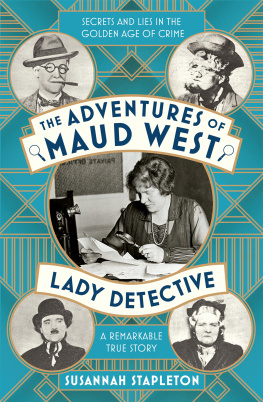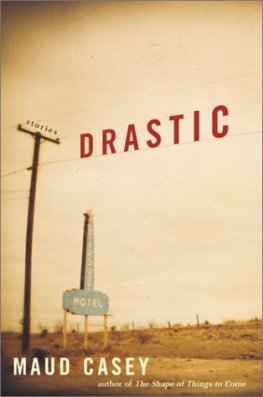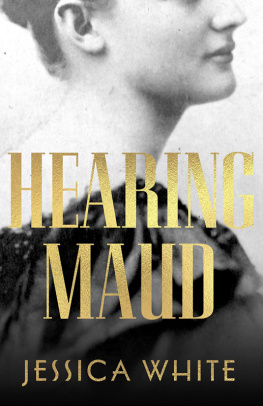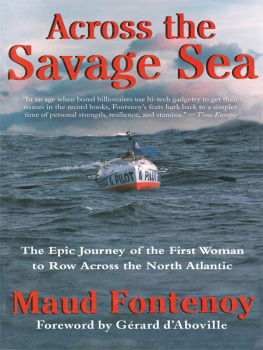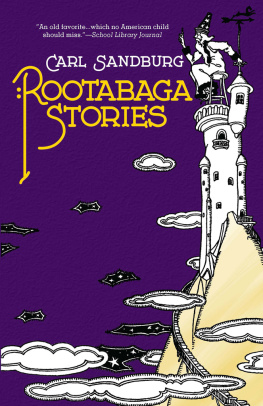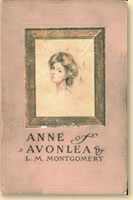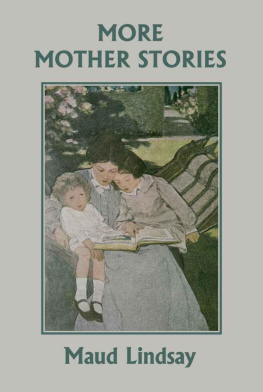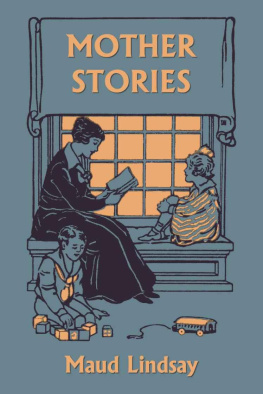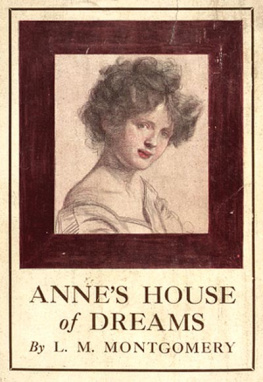The Adventures of
Maud West, Lady Detective
If you are inclined to regard the Golden Age detective stories as obviously a fantasy form and never more fantastic than when the sleuth is a woman Susannah Stapletons book will astound you. Maud West was a real woman detective, but her story blurs the margin between possible truth and impossible invention till your head spins. If you are susceptible to Miss Marple and Harriet Vane you must read The Adventures of Maud West . You will never know the difference between fact and fiction again.
Jill Paton Walsh, author of the Peter Wimsey/Harriet Vane mysteries
I rocketed through this terrific book. A brilliant literary sleuth tracks down a real one, uncovering a flabbergasting hidden life along the way. And if you thought that detective novels exaggerate the amount of inter-war crime, you are wrong.
Lissa Evans, author of Crooked Heart and Old Baggage
A deliciously entertaining, meticulous and affectionate investigation into one of the great unsung heroines of British detection, our very own real-life, female Sherlock Holmes. Criminally good. Its impossible not to love this book.
Mel McGrath, author of Give Me the Child and The Guilty Party
A powerhouse of a book, both a biography of one of the first women detectives, and a portrait of the Jazz Age, that society perched uncomfortably between Victoria and modernism. But Susannah Stapletons more profound achievement is in encouraging her readers to follow along as she goes about the business of the historian and biographer, permitting us to watch history being uncovered in real time. The Adventures of Maud West, Lady Detective is, as one suspects Maud herself was, sweet, and wonderful company, and absolutely determined to discover the truth.
Judith Flanders, author of The Invention of Murder and the Sam Clair mysteries
Maud West is a gloriously English eccentric think Miranda Hart meets Margaret Rutherford brought to vigorous life by present-day sleuth Susannah Stapleton. Stapleton brings a keen eye for bizarre and quirky detail to this compelling tale of Londons leading female private detective in the days before the Second World War. But its also a charming and deeply felt love letter to a completely forgotten trailblazer who forged a complex life and successful career when many women were banished to the typing pool, the nursery or the kitchen.
Sean OConnor, author of Handsome Brute
Susannah Stapletons dogged sleuthing of Mauds own complicated, messy, spunky life reveals the wider story of a little-explored sliver of life between the wars: female detection with all its risks, boredoms, tawdry deceptions, disguises and necessary seductions. I loved it.
Kate Colquhoun, author of Mr Briggs Hat and Did She Kill Him?
For Sarah
Contents
- Such a Dull Job! Or, Fifteen Minutes with a London
Woman Detective: Interview with Maud West
Guide
Prologue
The Lady Vanishes
One evening in 1939, Maud West, Londons leading lady detective, locked the door to her Bloomsbury office and promptly disappeared, never to be seen again. Her exploits over the past thirty-four years had taken her around the world, snooping in drug dens, grand country houses, mental asylums and more. She had unmasked blackmailers, caught adulterers, foiled jewel thieves and shut down cults, all on behalf of a client list that could have been lifted from the pages of Debretts. The press loved her a real lady sleuth in the golden age of crime and newspapers across the globe reported tales of her derring-do.
And now she was gone.
As one would expect, Maud West had amassed a fair few nemeses over the years. But she wasnt abducted that night in 1939, nor was she killed or harmed in any way. She didnt hide out in a Harrogate hotel or wake up swathed in bandages, hurtling across Germany on a Hitchcockian train. She simply ceased to exist if it could be said that Maud West had ever truly existed at all.
That said, she used to be easy enough to find. If there was no London telephone directory to hand, a quick glance at the personals column of any major newspaper would do the job.

See? There she is.
Chapter One
The Documents in the Case
in all good faith to other women who would become detectives, I would utter one word of advice Dont.
Maud West, 1914
Maybe I should have walked away at the first sign of deceit; after the incident with the bear-skin rug, perhaps, or during that ridiculous car chase across Hampstead Heath. In Paris? Or Rio? There were so many times I could have turned back and just left her to it. But then I would never have met the Countess or the Prince of Lovers, or learned how to rig an office safe with chloroform or whip up a disguise using only a piece of orange peel and a wisp of goat hair. Id never have laughed with her or wept for her; Id never have seen what lay beneath. Besides, Im not sure I even had a choice. There was almost a sense of inevitability about the whole thing.
Looking back, you could say that our paths began to converge on Boxing Day 1984, when the magnificent Joan Hickson, in her first tweedy outing as Miss Marple, pottered into my familys sitting room to investigate The Body in the Library . Just shy of my twelfth birthday, I was immediately and irreparably entranced by the whodunnit, yes, and the frocks, the hats, the gigolos and jazz fiends, but, most of all, by the idea of all those delicious secrets lying so perilously close to the surface. Before long, Id sought out the books for my own private feasts of sparkling cyanide and arsenic-laced prawns, and taken up snooping on the side. By the time I was thirteen, I was eyeing up louche lipstick in the village chemist, sneaking the occasional cigarillo and dabbling in a bit of light blackmail. It was only the threat and subsequent reality of boarding school that put paid to an otherwise promising future as a Jazz Age reprobate.
Somewhere along the way, my talent for muckraking was guided into a career in history, where it was thought I could do less harm. But I never gave up the detective stories. If I learned anything from my two-year incarceration in a ladies college, it was that theres nothing like a good murder to lift the spirits. As the years went on, I put this to good use in what became something of an annual ritual: in the darkest days of winter, Id take a couple of weeks off work, build a nest by the fire and escape into a world of daggers, poisons, wrath and revenge. It never failed to beat away the winter blues. Until, that is, a few years ago.
All the usual elements were in place that winter: miserable weather, a build-up of petty resentments, a stack of green Penguins foraged from second-hand bookshops. Yet, however much I craved that state of rightness-with-the-world, where the bodies are all lined up, someone is on their way to the gallows and a cup of cocoa awaits before bed, I couldnt find a way in. As the first week wore on, a trail of half-read books lay scattered throughout the house, old friends abandoned mid-sentence: Harriet Vane motionless under the bed; Nero Wolfe sliding down the back of the sofa. I couldnt settle to anything.
Instead, my mind kept going back to a historical missing-persons case Id recently completed. It had arisen out of some exhibition work I had done for a museum, and my quarry had been a minor nineteenth-century inventor whose fate had stumped a small band of collectors and enthusiasts for decades. The case had taken me on an exciting jaunt, on paper at least, from Liverpool to Havana, with a small attempted coup in Spain along the way. There had been exploding steamships, secret marriages, royal pardons, family feuds and a sad, gin-pickled end. When I thought about it, Id been feeling a bit flat ever since. I missed the thrill of the chase.

